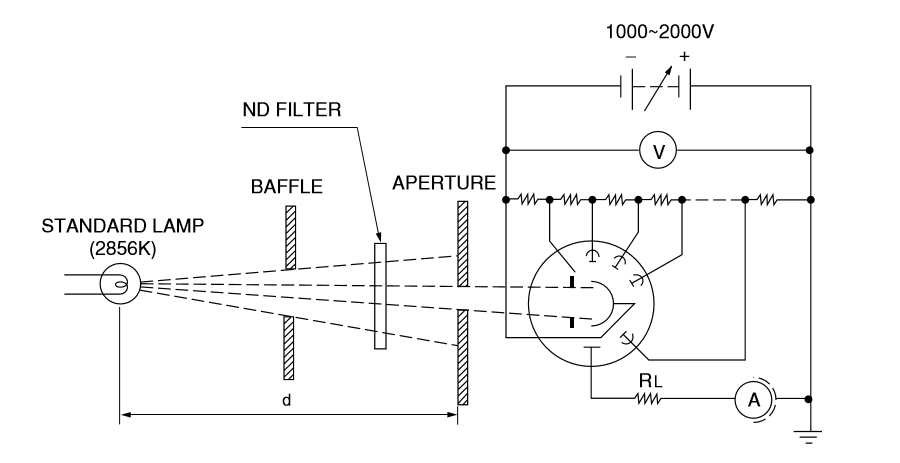Checking PMT performance over time

PMT performance can degrade over time. A friend asked mine recently ask for suggestions on how to check PMT performance. In a prior post, I mentioned that the Hamamatsu PMT Handbook talks a bit about the proper way to make calibrated measurements of PMT sensitivity.
If you don’t need calibrated numbers, and just want to compare PMTs to each other and over time with an inexpensive solution, then a simple approach can work:
I was just in CSHL to give a lecture for the imaging course. There, Michael Orger was putting together a black box with an LED and a PMT in it to teach the students about PMT gain and noise. Something like that might be handy for measuring PMT performance over time.
1. A light-tight box with a mount for the PMT.
2. An LED (with a ton of optical attenuation– using ND filters, for example)
3. A power meter to make sure that the LED is stable over time (this is your secondary standard, measure the LED at the same supply power, but without the optical attenuation used for PMT measurements)
You could have two compartments in the black box. Compartment 1 has the LED and the power meter sensor. Compartment 2 has the PMT. In between the two compartments is an almost opaque wall, which just lets a small flux of light through. This way, you can monitor the LED output with the power meter while making PMT measurements– to make sure there is no drift in LED brightness during measurements (as well as between measurement sessions). I’d want to do measurements at several different PMT voltages (ie, gain settings), to see if it changes.
As a postdoc I built a “point source” using a small vial of tritium, glued to an SM1 cap in an SM1 tube that held a pinhole. It’s an inexpensive & stable emitter, comes in different colors and can be integrated easily. Am pretty sure I got mine from http://tritiumkeychains.com that I learned about via http://candlepowerforums.com . May be useful here instead of the LED.
That’s cool! Thanks for the tip.
Great post. How would you envision splitting the light to both the PMT and power meter sensor? Some kind of beam splitter? Or would you just be using the background scattered light of the LED in the box to monitor LED stability? Would white LED make sense for this application?
I wouldn’t try to split the light using optics. I’d just use a broad angle emitter and have the meter pick up some of the photons. The meter is just to control for flux consistency (drift from session-to-session, or drift within a measurement session). It’s not quantitative. It’s crude and just intended as a spot check.
My 10770PA-40 protection circuitry is kicking in frustratingly often – I’d like to determine whether this is due to a fault in the PMT, degradation over time (as above), or a misconfiguration of e.g. preamplifier gain and/or DAQ range (current hypothesis). As I sit here looking at Hamamatsu specs, doing calculations and searching literature, I am missing answers to a few practical questions. I would greatly appreciate any pointers!
What is a typical dwell time for non-resonant in vivo GCaMP6 imaging?
How many photons are emitted by the soma of a neocortical GCaMP6 neuron under typical conditions? I realize this depends on many things, not least of all the specimen power and excitation NA, and that the # of photons detected will depend on depth of the neuron, collection optics, and much more.
Alternatively, some other measure of typical/max “brightness”? My goal is to estimate an appropriate combination of PMT gain, preamp gain, and DAQ input range that will keep me from damaging the PMT and/or engaging the protection circuitry, while still getting adequate image quality.
Thank you!
PS: I’m using SRS570 preamps, with one GaAsP and one multi-alkali Hamamatsu PMT.
I assume you’re running the SRS570 in low noise mode with 1mA/V gain? This would give you ~1MHz bandwidth so you could use pixel dwells down to 1 us. The trip threshold on the 10770 is 50 uA, so you’re going to trip at 50 mV going to the DAQ.
Be careful with the PMT trip. There is permanent damage every time the PMT trips.
This post along with the other post on measuring the gain of your PMTs are terrific. However, if one didn’t measure the performance of the PMT when it was new or I inherited a set of PMTs, how can I tell if they are still within in spec? Is there a standard source or calibration that I can use that will measure the absolute rather than the relative performance?
Thanks,
Matt
There are such standard sources, and Hamamatsu uses these at their factory. They talk about them a little in their PMT handbook. However, I don’t know of anyone selling calibrated standard sources to the same specifications. Comparing among PMTs in the lab is one way to get a rough idea. The lead times on PMTs from Hamamatsu are such that I suggest keeping spares in the lab (ditto for galvos).
You can buy stabilized light sources from Hamamatsu: https://www.hamamatsu.com/resources/pdf/etd/L11416_L11494_TACC1057E.pdf